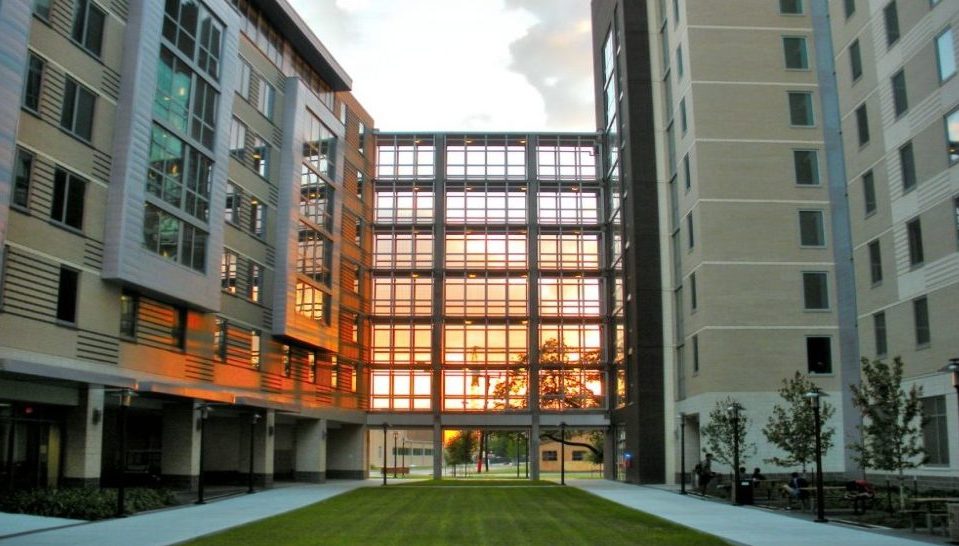More Beds Per Student on Campuses With Living Requirements

A typical university provides enough on-campus housing for roughly a fifth of its student body. However, that percentage tends to jump at universities with on-campus living requirements.
In analyzing the on-campus bed-to-enrollment ratios of the core 175 U.S. universities tracked by RealPage, we found that, on average, universities provide enough on-campus beds for 21.5% of its students. But there is a wide range among the 175 universities, and schools with higher on-campus bed-to-student ratios were also the schools more likely to require students to live on-campus a certain number of years.

Among the RealPage 175, Eastern Illinois University had the most on-campus beds per student in 2017. The school, which has about 5,500 undergrads and 1,500 graduate students, requires freshmen to live on-campus. The university’s decade-long shrinking enrollment has contributed to its growing bed-to-student ratio. While the university’s supply has been shrinking slightly as small amounts of rooms are taken out of commission, enrollment has been declining at a faster rate. In turn, on-campus occupancy stands at a measly 36%. The on-campus bed-to-student ratio has been growing since about 2005. Meanwhile, the off-campus bed-to-student ratio has also been growing, but at a slower pace, going from about 5.4% in 2007 to 11.5% in 2017, the latest year for which data is available.
At #2, Savannah State has also seen shrinking enrollment on and off over the last couple years. The Georgia school, which has about 4,500 students, has a 62.2% on-campus bed-to-student ratio and enough private, off-campus beds for only about a 3% of students. Occupancy on campus sits around 90%. Savannah State, which doesn’t have an on-campus living requirement, isn’t expected to see any new on-campus supply until 2020.
In Indiana, there have been a few more Fighting Irish students as Notre Dame has grown enrollment by just under 1% annually over the last several years. Its on-campus bed-to-student ratio has stayed between 53% and 60% over the last decade. At 55.7%, Notre Dame had the third highest on-campus bed to-student ratio in 2017. On-campus housing has had above-capacity occupancy since 2011, and thanks to a recent policy that requires freshmen, sophomores and juniors live on campus, university housing should stay above capacity for the next few years. The new policy took effect in Fall 2018 and is the strictest residency requirement among the 175 schools that RealPage tracks.
Enrollment at Clark Atlanta University has grown consistently over the last several years to stand at about 4,000 students in Fall 2017. The university has a higher-than-average on-campus bed-to-student ratio of more than 52%, the fourth highest nationally. Freshmen and sophomores must live on-campus, helping to bolster the university’s on-campus occupancy to over 96%. Though the school has had some well-publicized capacity issues, it’s not expected to see much new supply until about 2021.
At #5, UMass, which has a total undergrad enrollment of nearly 22,000, is the largest university in the top 10. The Amherst campus has a bed-to-student ratio of about 52%. With very little off-campus competition, UMass has kept on-campus occupancy above 97% for the last decade or so. Enrollment at UMass has been growing an average of 1.3% annually for the last decade, and the university has been adding on-campus beds to keep up with its new students.
Of the campuses in the top 10 that do not have residency requirements, they typically have a strong culture of dorm or residence hall life. For example, UConn has one of the highest percentages of students living on campus of any public university in the U.S. at more than 11,000 students, according to its website.
When looking at the living requirements for the next group of universities that landed just outside of the top 10 with ratios in the 35% to 42% range, more sophomore requirements are found, such as at Miami University in Ohio, Western Carolina, Texas Christian University, Stephen F. Austin State and Syracuse University.
In addition to campuses with living requirements, universities with lower enrollment tend to offer more on-campus housing for students. Conversely, on-campus bed-to-student ratios are typically lower at large universities with more than 30,000 students. In fact, of the 60 universities with enrollment above 30,000 in 2017, there were an average of 19 beds on campus for every 100 students. That’s below the national average of 21.5%.
On the low end of the on-campus bed-to-student ratio, a couple universities in the RealPage 175 have no on-campus supply. They include University of Michigan – Dearborn and Utah Valley University.

Most of the universities with the lowest bed-to-student ratios have no on-campus living requirements – such as Boise State, University of Central Florida, University of Texas at Arlington and Cal State Northridge – and about one-third require only freshmen to live on-campus – such as at Wichita State, University of New Mexico and University of Louisville.
None of the schools with the lowest on-campus bed-to-student ratio require sophomores or older students to live on-campus.






